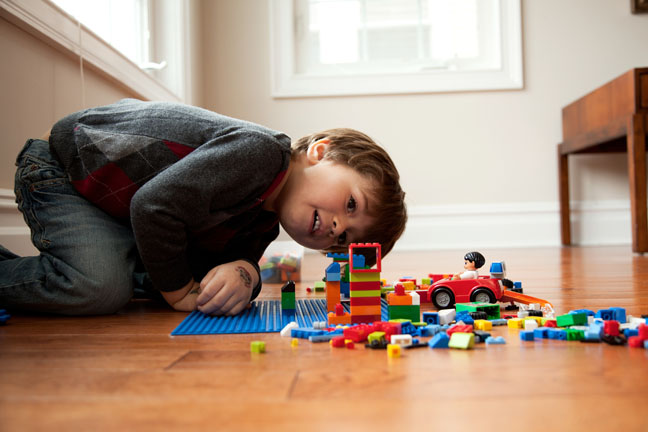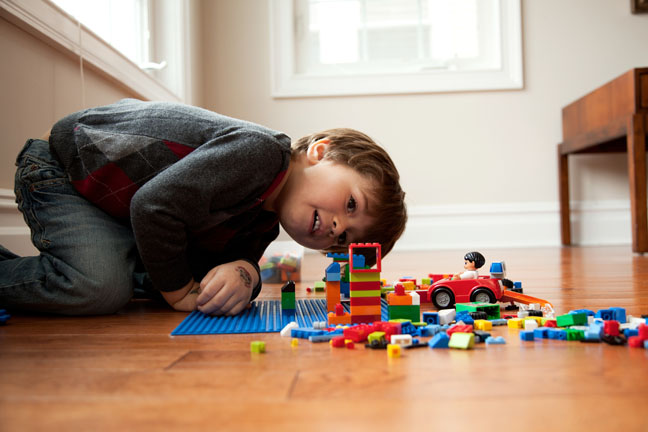Don’t underestimate the importance of imaginative play! When your little one snaps a picture or answers a pretend phone that’s actually a wooden block, it’s a big developmental milestone. Kids with a healthy imagination often view the world around them with a vivid and engaging curiosity, and grow up to be creative problem-solvers who find success in their lives. Here are 6 easy ways to boost your child’s imagination every day:
Read to Your Child
 Helping your child develop a life-long affinity for books by reading to him is one of the best ways to spark imagination skills. For the smallest ones, picture books are an excellent place to start. Colorful, fun and interactive books can fuel curiosity while subtly helping children to develop language and vocabulary skills. Check out a selection at the library and start reading to them daily. The kids will certainly let you know which books they favor: they’ll ask to hear them again, over and over! When a child hears a story, he creates vivid images in his mind. Reading to a child is an opportunity to for bonding and to broaden horizons at an early age.
Helping your child develop a life-long affinity for books by reading to him is one of the best ways to spark imagination skills. For the smallest ones, picture books are an excellent place to start. Colorful, fun and interactive books can fuel curiosity while subtly helping children to develop language and vocabulary skills. Check out a selection at the library and start reading to them daily. The kids will certainly let you know which books they favor: they’ll ask to hear them again, over and over! When a child hears a story, he creates vivid images in his mind. Reading to a child is an opportunity to for bonding and to broaden horizons at an early age.
Scientists have confirmed that reading to a child for only 30 minutes per day, and doing so with consistency, helps to develop creativity and imagination. Researchers have mapped the human brain extensively and are able to pinpoint the brain centers for creativity and imagination. When activity centers in these areas of the human brain, new synapses—connections between brain cells—are formed. Using these synapses repeatedly strengthens them as the child grows and matures. And it’s critical to form strong connections in the brain at an early age.
Play with Your Child

Creativity and imagination are so important because they provide the foundation for other skills that your child will need throughout his life. Playful imagination games are an opportunity for parent and child bonding, and will delight the child with an activity that is both fun and educational. With hectic family schedules, it may seem daunting to find the time to sit and play, and that’s when your own creativity and imagination can help!
In the car, a long line, or stuck in traffic is the perfect time for a game with your child and the activity will keep him happy and occupied during long waits. Take imaginary animals from your pockets for your kids to feed, assign names and personalities to these imaginary pets—play with and put them to bed. What’s his favorite animal? Knowing that helps you decide if you have a pocket loaded with monkeys or brimming with bears!
Play What animal am I? by making sounds for your child to identify, or refine the game further to What bird am I? and coo like a dove, caw like a crow, or trill like a robin, Kids will love stumping you with their own impersonations, gobbling like a turkey or squawking like a parrot.
Play games that hone observational skills like I Spy and have a contest to see who can spot the most items of a certain color, or make up silly songs that include the names of family members, friends, or pets. Channel a little Dr. Seuss to get into the spirit of crazy rhymes! The important part of any game is to engage the child and get him thinking creatively while having some silly fun.
Create Art

You don’t need fancy equipment—this can be as simple as handing your child a box of sidewalk chalk on a summer day! There’s something wonderful that happens when kids give free reign to their imaginations through arts and craft projects.
A first-time parent is often surprised to find their toddler ignoring an expensive toy in favor of playing with the box it came in. Curiosity and imagination make the ordinary object have extraordinary appeal to children. Keep that in mind and stockpile everyday items that kids can use for creative art projects. Save the cardboard rolls from paper towels and toilet tissue, a box of old buttons (not for young kids who may swallow them or stick in little ears and noses) and a selection of crayons, paper, even items from nature like interesting leaves and twigs. Scraps of fabric, lengths of colorful yarn, paper doilies, and sprinkles of glitter have broad appeal to the young artist. Add a glue stick, colored construction paper, even some shiny bits of tinfoil and let your child get busy. Buy or make play dough and provide your child a sculpting session.
Supervise from afar to be sure kids are crafting safely, but let their own imaginations guide them on what they create. Allowing you child to be in control of his project allows him to show initiative and exercise freedom of choice, both of which encourage creativity. Coloring and painting, molding and building are fun and tactile experiences that foster a child’s imagination and may even help develop artistic skills. Sure, some of their projects may improve with your advice and input (“Do you really think that horse should be pink?”) but don’t interfere or squelch your child’s vision. Let him make his own special creations in his own unique way.
Be Choosy about Toys and Games

More and more, we are becoming a “plugged in” society with television as an electronic babysitter and lots of similar options to keep kids occupied, including computers, video games, iPods, and Wii. Too much screen time actually encourages kids to be passive, and can be unhealthy for both the mind and the body. Limiting these types of activities in favor of more creative pursuits can spark young imaginations. Choosing the right toys and games that offer children plenty of play options are better for development.
Select toys that inspire imagination and construction, and also try open-ended toys that allow the child to decide how to use them. Toys like building blocks, puppets, animal figures and dolls, LEGOs and similar items provide hours of fun and countless opportunities for kids to stretch their imaginations. Role-play toys are great options too, because they encourage kids to play make-believe: cooking dinner in a kid-sized kitchen, or building a house with a child-size tool set, camping out in a tent made with a sheet strategically draped over a table, or creating a cabin out of an over-sized cardboard carton.
Avoid toys that only require kids to press a button or watch a video. Instead, visit a local thrift store and buy a selection of dress-up clothes and accessories. Kids will relish costuming themselves as pirates and policemen, nurses and princesses. A few well-chosen pieces and props will keep them busy for hours of imaginative play.
Get Moving Outdoors

Exercise is great for you and your children, and it’s another opportunity to spend time together and help your child make discoveries that will enhance her imagination. Walks and hikes together highlight the joys of nature, with many extraordinary sights that are new and intriguing to little ones.
Pack a lunch and take extra bread for the birds! Bring along binoculars so kids can study the scenery in an entirely new way, and let the day unfold. You really don’t always have to plan ahead because the questions and interest will come naturally as you walk. Look for perfect fall leaves to press as a memory, see how many species of birds you can spot, feed the ducks at a pond, or skip stones on a lake. Point out tiny seedlings that will grow to towering trees by the time your child is an adult. Talk about how the mountains and hills were formed and where the river empties. Have conversations that will inspire the child’s imagination and curiosity. Where are the birds flying to? How high can a squirrel climb in a tree? Did indigenous cultures, buffalo herds, or large black bears once make their homes near to where you are walking now? Nature provides the canvas, and the images you and your child discover together can ignite imagination. The venue can be a local or state park, a neighborhood path, or a hiking trail. Just choose a safe and easy-to-access area with plenty of variety in scenery to keep kids engaged and interested. A child who is exposed to new things has a creative advantage. The more varied a child’s experiences, the more potential there is for the child to become a problem-solver. Introducing your children to the wonders of nature is a good place to begin this process.
Talk and Tell Stories

It’s important for a parent to encourage her child to use his mind and imagination at every opportunity. Interaction allows the parent to stimulate and mature this developing mind, the child’s natural curiosity, and their creative skills.
Storytelling is the cornerstone of imaginative development, but it’s also a fun and easy way to strengthen your connection to your child. Your kid loves hearing stories about his parents growing up, about friends and relatives, favorite pets, and especially any story in which he—your child—is a featured character! Make up your own stories about things that your child likes, and encourage him to contribute some of the details themselves.
Create a round-table story with each family member taking turns. One person starts the story, then passes it on to the next to continue the tale, moving around the table in turns. The twists in the plot as each person uses her imagination to advance the story are usually surprising and always interesting, highlighting each individual’s unique personality.
Of course you are constantly talking to your children, but are you talking to them about the people and places you’ve experienced yourself? Children have a great curiosity about their own parents, and will be immediately interested when you share stories of your own childhood experiences, friends and activities. Now, they see you as just Mommy but tales about your unique life will engage your kids’ imaginations and allow them to picture you quite differently: as a baby, a child, a teenager, a college student, or a young career professional. Share some of your story with your brood, and allow the kids to imagine what their own futures may be.
images: Getty








